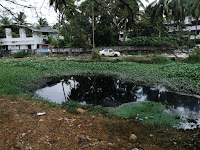Today, I had an opportunity to visit the basin of Puzhakkal river, under the tie up project between the Water Resources Department, Govt of Kerala and Department of Civil Engineering, FISAT. The day was full of surprises that had both ups and downs as an engineer and an individual. I was so happy to meet one of my early day mentors as a teacher at the Irrigation Department Office. We had an elaborate discussion as to how to move forward with the work that has been undertaken.
For the uninitiated, we are working on the Project for Pollution Abatement of Rivers in Kerala. The rivers are those ear marked as the most polluted by the CPCB and the National Green Tribunal of India. Even though a priority five river, Puzhakkal river being one of the largest source of irrigation to some 13,000 hectares of kole farming needs urgent retribution as a clean river.
A joint site visit was conducted by the Executive Engineer of the Irrigation Department at Thrissur who is also the nodal officer for the program and Unni sir and myself from the college.
An hour’s primary discussion with the members from the Irrigation Department, Hydrology division and KERI gave us a great insight into the polluted stretches of the river, potential sources of pollution in the river.
The site visit ensued which had the basic purpose of getting a feel of the issues faced, major areas to be covered while data collection and sampling. It gave us a grim picture of the river which feeds acres of kole farm lands in the district of Thrissur. The river is fed by a lot of tributaries and small streams and canals. Some of the important tributaries were found to be septic at points.
The residential areas, hospitals, commercial complexes within the corporation limit of Thrissur were found to have a deep impact on the ecology of the river. A total disruption of the ecosystem was evident at places. There was putrefying odor at more than one location in the canals and tributaries which evidently has been polluting the river. The presence of organic loading was visible. Water was brackish and no sign of fish life was available.
The biggest concern to the upkeep of the river is the tendency of people to dispose off Solid waste generated directly into the canals which end up at the river. Also, the disposal of septic waste, treated and untreated sewage from residential and commercial units, hospitals and other public entities like Thrissur Railway Station, KSRTC bus stand etc. was found to be affecting the quality of otherwise pristine canals that feed the river.
It will be a tough task rejuvenating the river without the support of the population. All work that we would be putting into the sampling, testing and planning pollution abatement techniques will be ineffective if the people are unwilling to change.
Upkeep of the quality of the river water is not just about sustainability of the river, kole farms but also about rejuvenation of flora and fauna that have been lost or on the brink of extinction in the river basin.
Jawahar Saud
Assistant Professor
Department of Civil Engineering








👍well said sir.... it’s a good initiative.... all the best
ReplyDeleteStep one to this herculean task done...now looking forward to add some value to this great work.
ReplyDeleteAs expected, informative and fun. Hope to see more of these in the future.
ReplyDelete